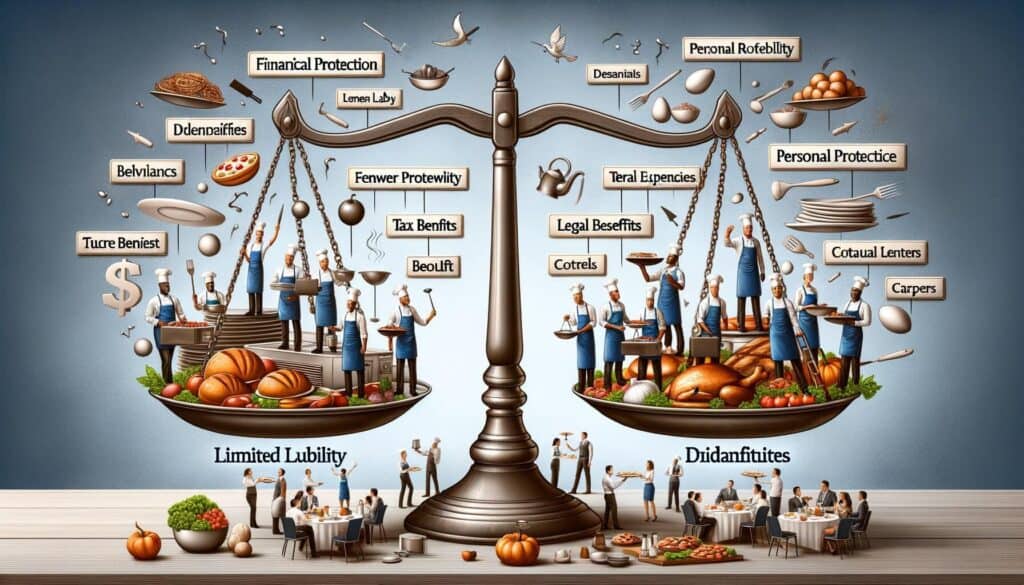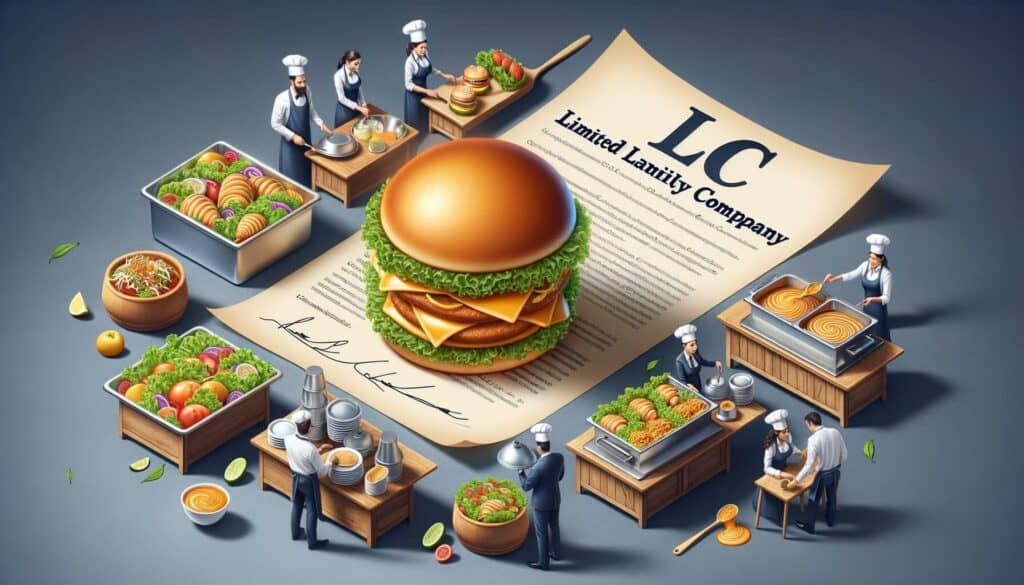
By Jermaine Thomas March 18, 2025
When starting a catering business, one of the most important decisions you will make is choosing the right business structure. The structure you choose will have a significant impact on your business’s legal and financial aspects, as well as your personal liability. There are three main business structures to consider: sole proprietorship, limited liability company (LLC), and corporation.
Each structure has its own set of advantages and disadvantages, and it’s crucial to understand them before making a decision. In this article, we will explore the pros and cons of each structure and provide a step-by-step guide on how to set up each one for your catering business.
Sole Proprietorship: Pros and Cons for Catering Businesses

A sole proprietorship is the simplest and most common form of business structure. It is owned and operated by a single individual, making it an attractive option for small catering businesses. One of the main advantages of a sole proprietorship is the ease of setup and low cost.
Unlike other business structures, there are no formal legal requirements or paperwork to establish a sole proprietorship. Additionally, the owner has complete control over the business and can make decisions without consulting others.
However, there are also several disadvantages to consider. One major drawback is the unlimited personal liability that comes with a sole proprietorship. Since there is no legal distinction between the owner and the business, the owner is personally responsible for all debts and liabilities.
This means that if the business fails or faces legal action, the owner’s personal assets could be at risk. Another disadvantage is the limited ability to raise capital. Sole proprietors often struggle to secure financing since they cannot sell shares of the business or attract investors.
How to Set Up a Sole Proprietorship for Your Catering Business

Setting up a sole proprietorship for your catering business is relatively straightforward. Here is a step-by-step guide to help you get started:
1. Choose a business name: Select a unique and memorable name for your catering business. Make sure to check if the name is available and register it with the appropriate authorities.
2. Obtain necessary licenses and permits: Research the licenses and permits required to operate a catering business in your area. This may include health permits, food handling certifications, and business licenses.
3. Register for taxes: Obtain an Employer Identification Number (EIN) from the Internal Revenue Service (IRS). This will allow you to report and pay taxes for your business.
4. Open a business bank account: Separate your personal and business finances by opening a dedicated business bank account. This will help you track income and expenses more effectively.
5. Obtain business insurance: Protect your catering business by obtaining the necessary insurance coverage. This may include general liability insurance, property insurance, and workers’ compensation insurance.
6. Keep detailed records: Maintain accurate records of your business income and expenses. This will make tax filing easier and help you monitor the financial health of your catering business.
7. Market your business: Develop a marketing strategy to promote your catering services. Utilize online platforms, social media, and networking events to reach potential clients.
LLC (Limited Liability Company): Advantages and Disadvantages for Caterers

A limited liability company (LLC) is a popular business structure that offers the benefits of both a sole proprietorship and a corporation. It provides limited liability protection to its owners, known as members, while maintaining a flexible and less complex structure.
One of the main advantages of an LLC is the limited personal liability it offers. Unlike a sole proprietorship, the owners’ personal assets are generally protected from business debts and liabilities. This means that if the business faces financial difficulties or legal action, the members’ personal assets are not at risk.
Another advantage of an LLC is the flexibility it provides in terms of taxation. By default, an LLC is considered a pass-through entity, meaning that the business’s profits and losses are passed through to the members’ personal tax returns.
This allows for a simpler and more favorable tax structure compared to a corporation. Additionally, an LLC offers flexibility in management and ownership. Members can choose to manage the business themselves or appoint a manager, and ownership can be divided among multiple individuals or entities.
However, there are also some disadvantages to consider. One drawback is the additional paperwork and formalities required to establish and maintain an LLC. While not as complex as a corporation, an LLC still requires the filing of articles of organization with the appropriate state agency and the creation of an operating agreement. Additionally, an LLC may face higher taxes in certain situations, such as when it elects to be taxed as a corporation or has multiple members with different tax obligations.
Step-by-Step Guide to Forming an LLC for Your Catering Company

Forming an LLC for your catering company involves several steps. Here is a step-by-step guide to help you navigate the process:
1. Choose a business name: Select a unique and available name for your catering company. Make sure to include “LLC” or “Limited Liability Company” in the name.
2. File articles of organization: Prepare and file articles of organization with the appropriate state agency. This document typically includes basic information about the LLC, such as its name, address, and registered agent.
3. Create an operating agreement: While not required in all states, it is highly recommended to create an operating agreement for your LLC. This document outlines the ownership and management structure, as well as the rights and responsibilities of the members.
4. Obtain necessary licenses and permits: Research and obtain the required licenses and permits for your catering business. This may include health permits, food handling certifications, and business licenses.
5. Obtain an EIN: Apply for an Employer Identification Number (EIN) from the IRS. This is necessary for tax purposes and allows you to hire employees if needed.
6. Open a business bank account: Separate your personal and business finances by opening a dedicated business bank account. This will help you track income and expenses more effectively.
7. Obtain business insurance: Protect your catering business by obtaining the necessary insurance coverage. This may include general liability insurance, property insurance, and workers’ compensation insurance.
8. Comply with ongoing requirements: Familiarize yourself with the ongoing requirements for maintaining an LLC, such as filing annual reports, paying taxes, and updating member information.
9. Market your business: Develop a marketing strategy to promote your catering services. Utilize online platforms, social media, and networking events to reach potential clients.
Corporation: Is it the Right Structure for Your Catering Business?
A corporation is a separate legal entity that is owned by shareholders. It offers the highest level of personal liability protection and is often preferred by larger catering businesses or those planning to seek outside investment. One of the main advantages of a corporation is the limited personal liability it provides to its shareholders. The shareholders’ personal assets are generally protected from business debts and liabilities, similar to an LLC. This means that if the corporation faces financial difficulties or legal action, the shareholders’ personal assets are not at risk.
Another advantage of a corporation is the ability to raise capital through the sale of shares. Unlike a sole proprietorship or an LLC, a corporation can issue stock and attract investors. This makes it an attractive option for catering businesses that require significant funding for expansion or equipment purchases. Additionally, a corporation offers more credibility and prestige compared to other business structures. It may be perceived as more established and trustworthy, which can be beneficial when attracting clients or negotiating contracts.
However, there are also some disadvantages to consider. One major drawback is the increased complexity and formalities associated with a corporation. It requires the filing of articles of incorporation, the appointment of directors and officers, and the adherence to corporate governance rules. Additionally, a corporation is subject to double taxation. This means that the corporation’s profits are taxed at the corporate level, and any dividends distributed to shareholders are taxed again on their personal tax returns.
Incorporating Your Catering Company: A Detailed Walkthrough
Incorporating your catering company involves several steps and requires careful consideration. Here is a detailed walkthrough to help you navigate the process:
1. Choose a business name: Select a unique and available name for your catering company. Make sure to check if the name is available and comply with any naming requirements set by the state.
2. File articles of incorporation: Prepare and file articles of incorporation with the appropriate state agency. This document typically includes information about the corporation, such as its name, address, purpose, and stock structure.
3. Appoint directors and officers: Select individuals to serve as directors and officers of the corporation. Directors are responsible for overseeing the corporation’s activities, while officers handle day-to-day operations.
4. Create corporate bylaws: Draft corporate bylaws, which outline the rules and procedures for operating the corporation. This document covers topics such as shareholder meetings, director responsibilities, and officer roles.
5. Issue stock certificates: If you plan to have multiple shareholders, issue stock certificates to document their ownership in the corporation. This provides evidence of their investment and ownership rights.
6. Obtain necessary licenses and permits: Research and obtain the required licenses and permits for your catering business. This may include health permits, food handling certifications, and business licenses.
7. Obtain an EIN: Apply for an Employer Identification Number (EIN) from the IRS. This is necessary for tax purposes and allows you to hire employees if needed.
8. Open a business bank account: Separate your personal and business finances by opening a dedicated business bank account. This will help you track income and expenses more effectively.
9. Obtain business insurance: Protect your catering business by obtaining the necessary insurance coverage. This may include general liability insurance, property insurance, and workers’ compensation insurance.
10. Comply with ongoing requirements: Familiarize yourself with the ongoing requirements for maintaining a corporation, such as filing annual reports, holding shareholder meetings, and maintaining corporate records.
11. Market your business: Develop a marketing strategy to promote your catering services. Utilize online platforms, social media, and networking events to reach potential clients.
Frequently Asked Questions (FAQs) about Structuring Your Catering Business
Q1: What is the best business structure for a small catering business?
A1: The best business structure for a small catering business depends on various factors, such as personal liability concerns, financing needs, and long-term goals. Sole proprietorship and LLC are often suitable options for small catering businesses due to their simplicity and flexibility.
Q2: Can I change my business structure in the future?
A2: Yes, it is possible to change your business structure in the future. However, it may involve additional paperwork, legal fees, and potential tax implications. It is advisable to consult with a business attorney or accountant before making any changes.
Q3: Do I need a lawyer to set up my catering business?
A3: While it is not mandatory to hire a lawyer, consulting with one can be beneficial, especially when it comes to legal and regulatory compliance. A lawyer can help you navigate the complexities of business structures, contracts, and intellectual property issues.
Q4: Can I start as a sole proprietorship and later convert to an LLC or corporation?
A4: Yes, it is possible to start as a sole proprietorship and later convert to an LLC or corporation. However, the process may vary depending on your jurisdiction and may involve additional paperwork and fees. It is recommended to consult with a business professional to ensure a smooth transition.
Q5: What are the tax implications of each business structure?
A5: The tax implications vary for each business structure. Sole proprietorships and LLCs are typically considered pass-through entities, where the business’s profits and losses are reported on the owner’s personal tax return. Corporations, on the other hand, are subject to double taxation, where the corporation pays taxes on its profits, and shareholders pay taxes on any dividends received.
Conclusion
Choosing the right business structure for your catering business is a crucial decision that will impact your legal and financial obligations. Each structure has its own set of advantages and disadvantages, and it’s essential to carefully consider your specific needs and goals.
A sole proprietorship offers simplicity and low cost but comes with unlimited personal liability. An LLC provides limited liability protection and flexibility but requires additional paperwork. A corporation offers the highest level of personal liability protection and the ability to raise capital but involves more complexity and double taxation.
By understanding the pros and cons of each structure and following the step-by-step guides provided, you can make an informed decision and set up your catering business for success.